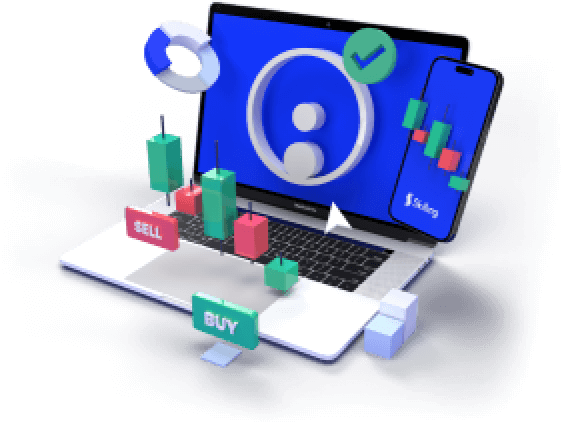Access 1,200+ global CFDs instruments.
Access a plethora of trading opportunities across the financial markets.

Access 1,200+ global CFDs instruments.
Access a plethora of trading opportunities across the financial markets.

As a trader, grasping market trends, managing risks, and keeping up with economic indicators are crucial to your success. However, one key metric often flies under the radar: the long-short ratio. Mastering this concept can unlock valuable insights and enhance your trading strategies. So, what exactly is the long-short ratio?
What is the long-short ratio?
The long-short ratio is a financial metric that evaluates the balance between long (buy) and short (sell) positions within a portfolio or market. It illustrates the proportion of long positions to short positions, serving as a barometer for investor sentiment and prevailing market trends. A higher long-short ratio signifies bullish sentiment, while a lower ratio hints at bearish attitudes. By understanding this ratio, traders can uncover essential insights into market movements and potential trading opportunities.
Example for clarity
To clarify, let’s consider an example involving a hedge fund manager named Sarah. She oversees a diverse portfolio of stocks, maintaining both long positions (assets she owns with the expectation of price appreciation) and short positions (assets she has sold with the anticipation of price depreciation.
To calculate her long-short ratio, Sarah counts her shares in long positions and compares them to her short positions. For instance, if she holds 1,000 shares in long positions and 500 shares in short positions, her long-short ratio is 2:1. This means that for every short position, she has two long positions.
Practice with a Demo Account
Try our demo account and experience real market conditions.

Analyzing this ratio gives Sarah insights into her market outlook. A ratio skewed toward long positions indicates optimism, while a lower ratio suggests a more cautious approach. By leveraging this understanding, she can assess her risk exposure, make informed investment choices, and adjust her portfolio as necessary. This metric serves as a vital tool for navigating the complexities of the financial landscape.
Why is the long-short ratio important for traders?
The long-short ratio is crucial for traders for several compelling reasons:
1. Gauging Market Sentiment
This ratio provides a window into market sentiment and investor confidence. A high long-short ratio often reflects bullish sentiment, indicating a strong inclination toward buying and holding assets. Conversely, a low ratio may signify a bearish sentiment, suggesting a greater tendency to sell or short assets. Traders can use this insight to align their strategies with prevailing market attitudes.
2. Enhancing Risk Management
Understanding the long-short ratio aids traders in managing their risk exposure effectively. By examining the ratio, traders can assess whether their portfolios lean more toward long or short positions. A significant bias toward long positions may indicate heightened risk due to potential market declines, while an increased focus on short positions could offer a hedge against downturns. This awareness enables traders to rebalance their portfolios and mitigate risks.
Trade Demo: Real trading conditions with zero risk
Trade risk-free on Skilling’s award winning platforms with a 10k* demo account.

3. Identifying Emerging Trends
Long-short ratios can reveal shifts in market trends and investor behaviors. Monitoring changes in the ratio over time can highlight evolving dynamics in the market and preferences for certain assets. For instance, an uptick in the long-short ratio may point to a growing inclination to buy and hold assets, signaling a potential bullish trend. Traders can leverage these insights to spot opportunities and tailor their trading approaches accordingly.
4. Acting as Contrarian Indicators
Extreme long-short ratios can sometimes serve as contrarian indicators. When the ratio reaches notably high or low levels, it may suggest an overcrowded trade, where most traders are positioned in a single direction. This scenario could indicate a looming market reversal. Savvy traders who recognize these contrarian signals might position themselves to capitalize on shifts in sentiment.
What's your Trading Style?
No matter the playing field, knowing your style is the first step to success.

Frequently Asked Questions (FAQs)
1. How is the long-short ratio calculated?
The long-short ratio is derived by dividing the number of long positions by the number of short positions. For example, if a trader holds 1,000 shares in long positions and 500 shares in short positions, the ratio would be 2:1.
What's your Trading Style?
No matter the playing field, knowing your style is the first step to success.

2. What does a high long-short ratio indicate?
A high long-short ratio signifies a greater number of long positions compared to short positions within a trader's portfolio. This suggests a bullish outlook, reflecting optimism regarding the market or specific assets.
3. What does a low long-short ratio indicate?
A low long-short ratio points to a higher proportion of short positions relative to long positions, signaling a bearish sentiment. This suggests that traders are more inclined to sell or short assets.
4. How can traders utilize the long-short ratio in their decision-making?
Traders can leverage the long-short ratio to gain insights into market sentiment, manage risk exposure, spot trends, and act as contrarian indicators. By understanding this metric, traders can fine-tune their positions, analyze market dynamics, and make informed decisions.











